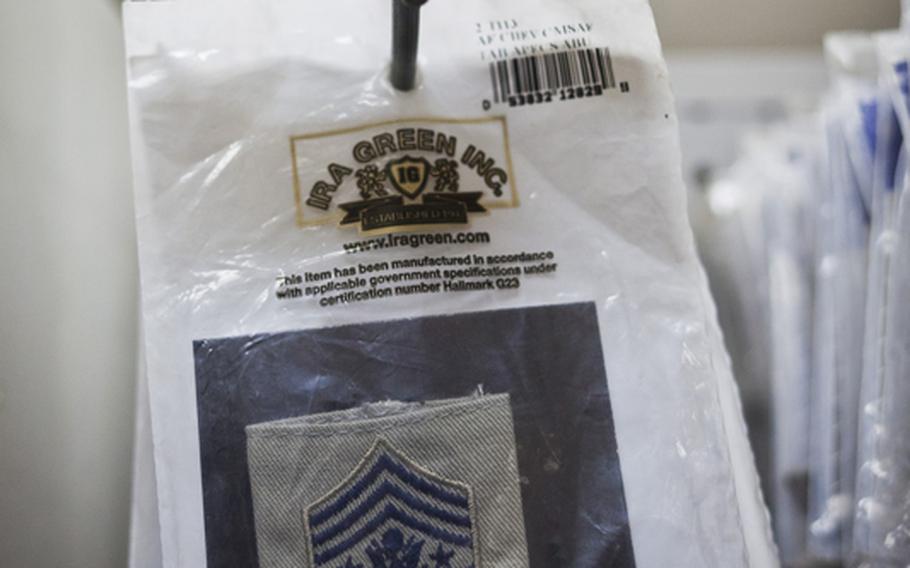
More than 20 cold weather GORE-TEX jacket patches for the Chief Master Sergeant of the Air Force are for sale at a Post Exchange at Victory Base Complex outside Baghdad, Iraq. Because you never know. (Nathan A. Bailey/Stars and Stripes)
SATHER AIR BASE, Iraq — If the chief master sergeant of the Air Force ever comes to Victory Base Complex, he won’t be in need of cold-weather uniform rank patches.
The post exchange near the Al Faw Palace carries 24 of the small patches that affix to uniform jackets and body armor, made from a material no sane person would ever wear on a 127-degree August day in Baghdad.
But if there were such a person, it would by default have to be Chief Master Sergeant of the Air Force James A. Roy, because he is the only active-duty servicemember in the military authorized to purchase that patch.
There were also roughly 160 fabric fastener patches for command sergeants major, just in case Baghdad ever holds a convention for soldiers at such a rarefied leadership rank.
“It’s strange,” said Cpl. Scott Emerson, of Coeur D’Alene, Idaho. “Maybe if they order one type, they have to order every other rank patch at the same time.”
Fortunately, Emerson hasn’t needed a patch during his deployment. The store didn’t have any patches for corporals.
Rambos in the ranks
I noticed a rather large soldier named Spc. Rambo on a flight from Ali Al Salem Air Base in Kuwait into Baghdad. With a name like Rambo, he has a lot to live up to in the Army.
It turns out he’s not the only one.
There are 55 uniformed or civilian Rambos in the Army, according to an Army Knowledge Online people search.
Of those, 28 are soldiers ranging in rank from Pfc. Jacqulinne Rambo to Lt. Col. Kyle Rambo.
Ever since that flight, I began wondering whether a name could have some subtle influence upon a person’s future occupation.
A few days later, I found Air Force Staff Sgt. William Warrior eating in a dining facility at Camp Taji. Appropriately enough for an air warrior, Warrior is a helicopter gunner.
In the lulls
As you can tell by now, in between writing about bomb attacks, Iranian influence in Iraq and the impending military drawdown, I’ve been asking the hard-hitting questions that readers like you care about most.
Questions like this one: Is chocolate pudding a “high-performance food for the superior athlete?”
It depends on what base dining facility you’re eating at.
Each base labels the food choices at its buffet-style dining facilities with one of three labels: green for high performance, yellow for moderate and red for low performance.
“We say here that if you combine a red with a green, it equals a yellow,” said Maj. Jim Deverteuil, of Boise, Idaho, and the 116th Cavalry Brigade Combat Team at Sather Air Base.
At Camp Ramadi, vanilla pudding only makes it to moderate, while chocolate pudding is relegated to the red zone. But at Sather, both flavors earn top performance billing, right up there with raw broccoli and carrot sticks.
“The sweet tea goes from red to green, depending on which chow hall you’re at,” Deverteuil added. “The best I can tell, they all have the same amount of sugar in them.”
I can’t let Ramadi off the hook completely. Hard-boiled eggs with shells get the moderate rating, but as a salad bar topping, they’re low-performance.
I suppose diners get less calcium when they don’t eat the shell.